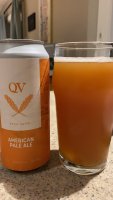The Verdict:
Figure we don't see enough end product on these forums. Plenty people asking questions, but few results ever posted, after the questions been answered, if any. While still very young in the bottle, here is something of an update - for any who care.
As you can see, I am a lowly bottler. My larger than average offspring volume (4 kids) is lucky to permit me a few buckets, a bag and a kettle, let alone a 3 vessel kegging outfit. Lautering will have to wait.
So the APA has been in the bottle 1 week. I always give a bottle or two a go after a week to check carbonation. It generally results in rather rapid consumption of green beer unfortunately. Before cooling, I can see right thru the bottles. Very clear. I assume what I am seeing in the glass is chill haze. Not much I can do about that but wait, I suppose. Got a couple of older lagers in back of fridge, and they are now quite bright. I doubt these APA will make it that long.
I have been drinking a fair bit of QV APA lately (see picture). One of my favourite beer styles of late. This SNPA Clone I made is a decent rendition of the QV product. In a week or two, if they last, then I should be getting a little better head retention, lacing, what have you.
I am beginning to get what people say about quantity of Crystal malts in these styles. While I do like the taste, my hop additions and bitterness are spot on, there is a certain amount of (what others have termed) "cloying taste" with crystal. Its not an entirely bad thing, and I can see how some might really like it, even strive for it, but I think my beer would be improved if I could some how remove that (what seems to me) later after taste in this beer.
As such, I made up a batch of what is actually deemed an amber lager yesterday. 11 LBS 2-row, 1 LB Munich, and just 0.5 LB C-40. Also using a lager yeast, so it will likely be quite different. I want to see how much of the crystal I can perceive.























































![Craft A Brew - Safale S-04 Dry Yeast - Fermentis - English Ale Dry Yeast - For English and American Ales and Hard Apple Ciders - Ingredients for Home Brewing - Beer Making Supplies - [1 Pack]](https://m.media-amazon.com/images/I/41fVGNh6JfL._SL500_.jpg)




